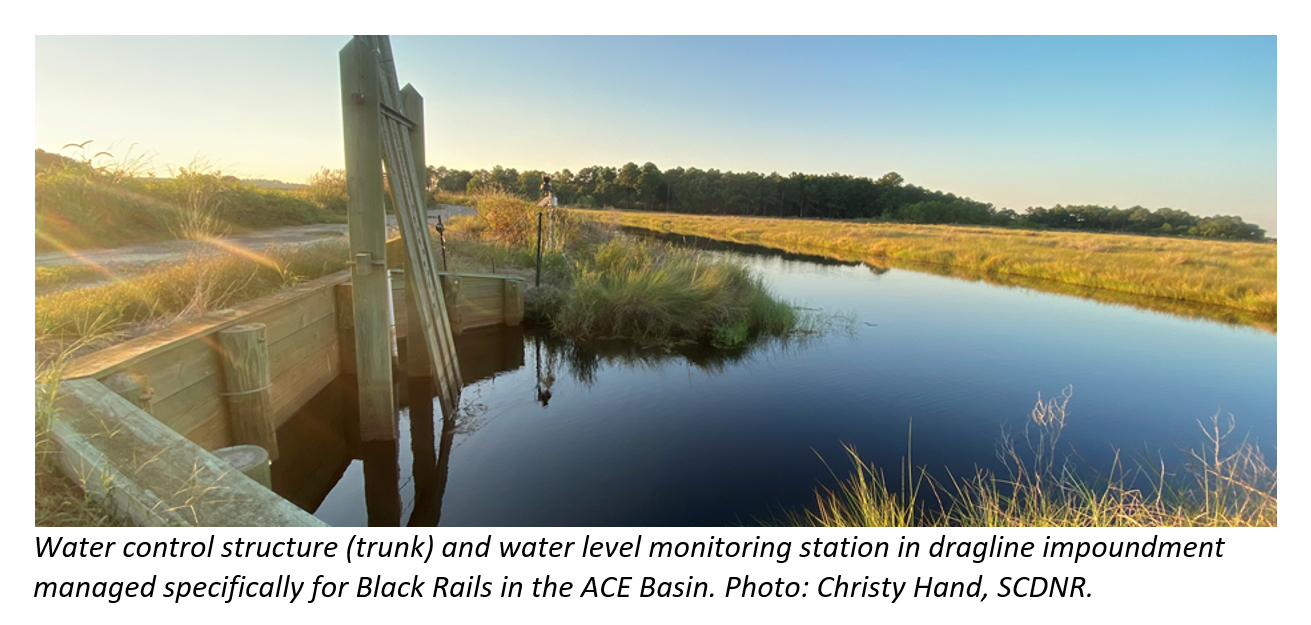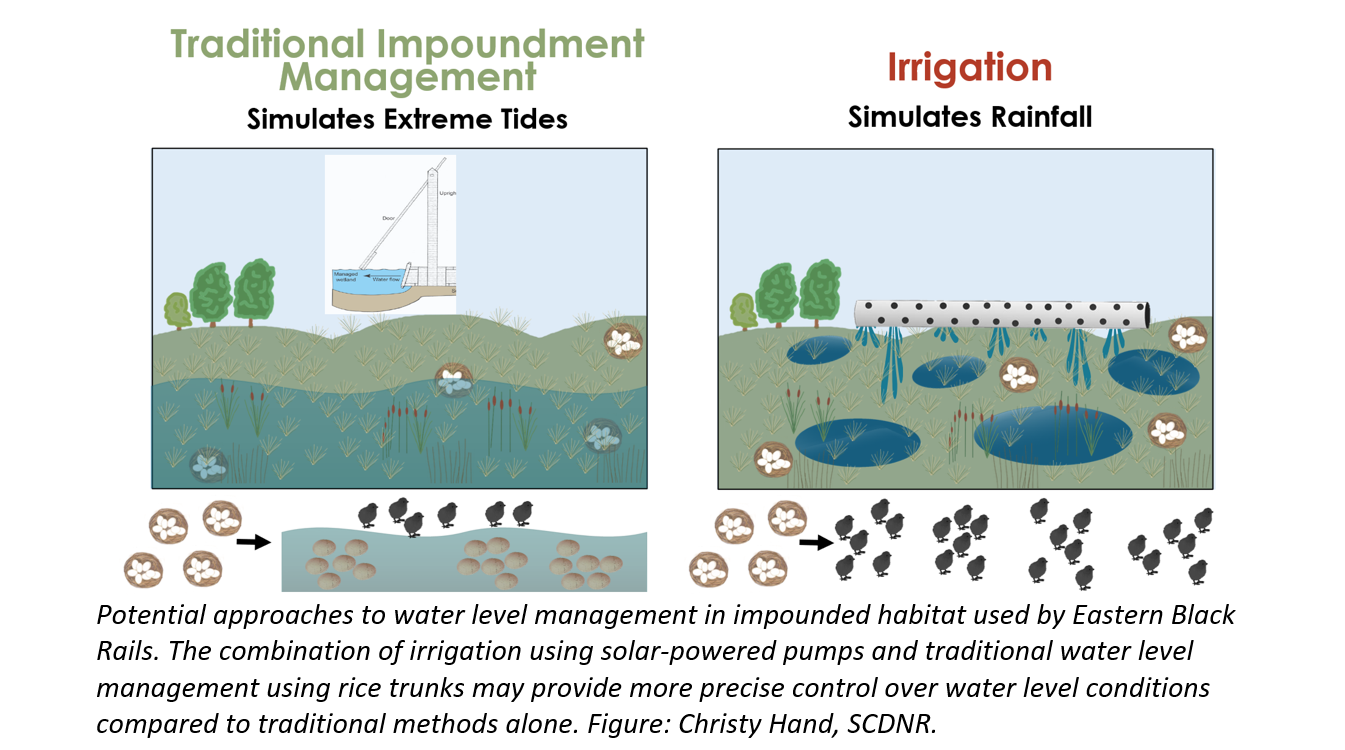
Habitat Management Considerations
Conservation Opportunities in Coastal South Carolina
As Black Rail population numbers on the Atlantic Coast have plummeted by as much as 90% in mid-Atlantic states, Black Rails have persisted in two areas of South Carolina – the ACE Basin and the Santee Delta regions. Long-term investments in wetland management for waterfowl hunting have helped to sustain Black Rails.
Although Black Rails have fared better in South Carolina compared to neighboring states, threats such as storms during vulnerable periods and the loss of habitat diversity are increasing. Targeted habitat management is needed to ensure their long-term survival.
Prioritizing Wetlands for Management
Not all wetlands have the potential to provide optimal breeding habitat for Black Rails. To utilize resources efficiently, it is necessary to identify the types of wetlands that offer the highest potential to support population growth and to focus intensive management efforts in these wetlands. Landowner/manager commitment to sustained management dedicated to Black Rails is as important as having suitable physical characteristics. If managing a wetland specifically to benefit Black Rails is not compatible with landowner priorities, it should not be considered to be a high potential wetland.
Intensive Management for Black Rails
Intensive management for Black Rails should be pursued in high-potential habitat where dedicating the wetland to management specifically for Black Rails is compatible with landowner priorities. Black rail-scale (rail-scale) management is necessary for successful breeding and requires far more precise and strategic water level manipulations compared to waterfowl-scale management.
The best impoundments for Black Rails often are of low value to other priority waterbirds such as waterfowl, shorebirds, and wading birds. By identifying and implementing targeted management for Black Rails within a relatively small number of suitable impoundments (typically dragline impoundments rather than former rice fields), it may be possible to have a substantial positive effect on Black Rail population numbers without diminishing property-wide management objectives. Many of the plants that provide excellent habitat for Black Rails are considered to be undesirable for other management objectives. These species include sand/clump cordgrass (Spartina bakeri), saltmarsh hay (Spartina patens), marsh fimbry (Fimbristylis castanea) and saltgrass (Distichlis spicata). The presence of these plants can be helpful in identifying areas with potential to support Black Rails.
Black Rail-Friendly Practices
In wetlands where only a small amount of habitat is likely to be suitable and/or where management for other species is the priority, the incorporation of Black Rail-Friendly Management Practices can still benefit rail conservation. When rainfall conditions are ideal, Black Rails have been found in small patches of marsh habitat along the edges of impoundments. It may not be possible to continuously prioritize management of the entire impoundment to benefit Black Rails, but the following practices still may increase survival and breeding success when rails are present.
Recommendations include:
Minimizing the magnitude of flooding during vulnerable periods. These are the nesting and brood rearing period, which is from April 1 to September 30 in South Carolina and the flightless molt period, which is from August 1 to October 31.
Minimizing the duration of flooding during vulnerable periods.
Minimizing or avoiding burning during vulnerable periods (especially during flightless molt). Best Management Practices for Prescribed Burns are provided by the U.S. Fish and Wildlife Service.
Maintaining suitable grassy vegetation in high elevation areas of wetlands and in connected uplands.
Intensive Management Strategies
Targeted Impoundment Management
Dragline impoundments in coastal South Carolina provide some of the most immediate opportunities to rapidly incorporate management for Black Rails into existing management plans and priorities. A high level of personal commitment from the individual people who will be performing the management actions is critical. The management of impoundments for Black Rails is difficult and time consuming because the rails require a much narrower range of conditions compared to waterfowl, shorebirds, and wading birds. Even brief lapses in targeted management during critical periods could have severe impacts.
Irrigation
Solar-powered irrigation can be used to supplement rainfall in wetlands or wet meadows that otherwise would provide suitable habitat. This approach is currently being tested on properties in the ACE Basin and Santee Delta regions.
Detailed overview of a Solar-Powered Irrigation Pump System installed during 2023 to irrigate an experimental management plot for Black Rails. This project is part of a collaboration between the Nemours Wildlife Foundation and the South Carolina Dept. of Natural Resources. Funding provided in part by State of the Birds Grant F22AP00518. Video by Mikayla Thistle, SCDNR.
Disclaimer: Reference to any specific product or company is for the information and convenience of viewers and does not constitute endorsement.
Altering Topography and Hydrology
It may be possible to alter the topography and hydrology in wetlands or meadows that do not currently have compatible characteristics. With modifications to topography and/or irrigation to supplement rainfall, agricultural land managed as wet pastures may offer habitat for Black Rails. Ditches previously used to drain land can be plugged to create shallow water conditions.
In historic rice fields, it may be necessary to clear/dig out quarter drains during maintenance. Material removed from the quarter drains can be used to create ridges or island within impoundments that otherwise would be too deep during portions of the breeding season. Management of woody vegetation will be necessary to maintain newly created habitat and should be considered prior to construction. When feasible, periodic deep flooding may be an effective method for suppressing shrub growth. This approach has not yet been tested in South Carolina.
Vegetation Management
To maintain suitable vegetation structure, it is necessary to actively manage for early successional habitat. All of the Black Rail management strategies require periodic vegetation management to prevent woody shrubs from outcompeting grasses and other herbaceous plants. A variety of tools are available, depending on the physical characteristics of the wetland, available time and funding, and overall management objectives for the property.
Winter Flooding
Flooding during the winter (early November – February) can be a very effective method to kill shrubs including groundsel bush (Baccharis halimifolia) and to enrich the soil and associated macroinvertebrate community. Due to infrastructure limitations (height of dikes), this method is not feasible in all impoundments. Traditionally, flooding during the spring and summer has been used to control vegetation but flooding during this time of year prevents use of the habitat by Black Rails. Nonbreeding season flooding maximizes the amount of time the wetland is suitable for the rails. Care should be taken to avoid killing desirable vegetation such as clump cordgrass with prolonged flooding. Managing water levels lower during March – October supports the growth of clump cordgrass and saltmarsh hay.
Mechanical Removal and/or Herbicide
When feasible, mechanical removal with or without the use of appropriate wetland-approved herbicide can be effective for managing small areas of habitat. When shrubs begin to dominate small islands and ridges within Black Rail habitat, cutting down the shrubs and treating the stumps with herbicide helps to restore desirable vegetation structure. In potential Black Rail habitat, these activities should be completed during October - March in South Carolina to minimize the risk to the rails.
Prescribed Fire
Fire is an important tool for maintaining early successional grassland habitat, however, specific practices should be used to avoid take under the Endangered Species Act. Best Management Practices for prescribed fire are provided in the U.S. Fish and Wildlife Service final listing published in the Federal Register (https://www.fws.gov/species-publication-action/threatened-species-status-eastern-black-rail-section-4d-rule-0) and must be applied to avoid unauthorized incidental take.
Best Management Practices for Prescribed Burns (USFWS 4(d) Rule):
Regardless of the size of the area under management with prescribed fire, a broad range of habitat conditions should be maintained by burning on a rotational basis, which supports black rail population maintenance and growth. In any given calendar year, at least 50 percent of the Eastern Black Rail habitat within the management boundary should be maintained in order to provide the dense overhead cover required by the subspecies. Management boundaries can include individual landholdings, e.g., a National Wildlife Refuge boundary, or be formed through landscape-level agreements across landholdings of different but contiguous ownerships. This percentage does not apply to landholdings smaller than 640 acres.
Where Eastern Black Rail are present, the application of prescribed fire uses tactics that provide unburned refugia allowing birds to survive a fire (e.g., using short flanking, backing fires, or similar approaches). Prescribed fire is applied under fuel and weather conditions (e.g., soil moisture and/or relative humidity) that are most likely to result in patchy persistence of unburned habitat to serve as refugia from fire and predators.
Ignition tactics, rates of spread, and flame lengths should allow for wildlife escape routes to avoid trapping birds in a fire. The application of prescribed fire should avoid fires, such as ring and strip head fires, that have long, unbroken boundaries and/or that come together in a short period of time and that consume essentially all vegetation and prevent Black Rails from escaping a fire. If aerial ignition is the chosen tool, ignitions should be conducted in such a way that large, fast- moving fires are avoided.
For additional information regarding the 4(d) rule, contact Morgan Wolf of the U.S. Fish & Wildlife Service South Carolina Field Office (morgan_wolf@fws,gov).
In some situations, fire can promote the growth of shrubs such as groundsel bush by allowing seeds to germinate on newly exposed soil. In these situations, management using deep flooding may provide more desirable results if it is possible (i.e. within impoundments).
Wetland-Upland Interface Refugia
In addition to creating and maintaining suitable breeding habitat, maintaining suitable vegetation structure in adjacent higher elevation areas (i.e., the wetland-upland transition zone) can be beneficial to Black Rails. Maintaining compatible land in the transition zone and maximizing connectivity of wet grassland habitat may reduce mortality during tropical storms and hurricanes. Since this transition zone and upland habitat is primarily used during extreme weather events, investing resources in this strategy is most appropriate for areas known to be occupied by Black Rails.







